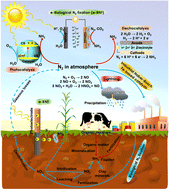Renewable electron-driven bioinorganic nitrogen fixation: a superior route toward green ammonia?
Abstract
Ammonia is crucial for the fertilizer industry and the global chemical economy. However, the conventional Haber–Bosch process for NH3 synthesis is energy and capital-intensive and associated with high greenhouse gas emissions (1.44% of global CO2 emissions). Thus, green ammonia synthesis that supports the green energy transition and sustainable development has become a research hotspot. Among others, nature-inspired bioelectrocatalytic nitrogen fixation (e-BNF), which combines the advantages of electrocatalysis, enzymes/microbes, and renewable energy, is emerging as one of the cutting-edge carbon-neutral, energy-efficient, and potentially sustainable strategies for ammonia synthesis. Nevertheless, the development of e-BNF is still in its infancy. Herein, we present a systematic assessment of the historical development and current state of e-BNF for ammonia synthesis. First, we revisit the conventional Haber–Bosch process and abiotic electrocatalysis approaches and access the fundamentals, merits, and challenges of bioinorganic e-BNF in the context of electrochemistry and bioelectrochemistry. Second, the electron transfer mechanisms, and enzyme- and microbial cell-based e-BNF are thoroughly discussed. At the end, we discuss future developments and perspectives on bioelectrocatalytic ammonia synthesis.



 Please wait while we load your content...
Please wait while we load your content...